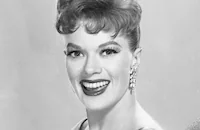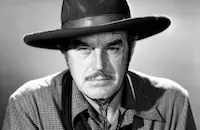One Sunday Afternoon

Brief Synopsis
Cast & Crew
Raoul Walsh
Dennis Morgan
Janis Paige
Don Defore
Dorothy Malone
Ben Blue
Film Details
Technical Specs

Synopsis
At the turn of the century, New York dentist Biff Grimes tries to start a new practice after spending a year in prison. One Sunday afternoon, while reminiscing about his old neighborhood with his friend, Nick, the barber, Biff receives an emergency call to pull alderman Hugo Barnstead's aching tooth. Biff carries a grudge against Hugo, a man he has known since his youth, and while picturing his revenge, agrees to help him. Biff's rivalry with Hugo began years earlier when both men were in love with beautiful Virginia Brush: One day, Hugo drives up in a new car and invites Biff to go riding with him, Virginia and her friend, Amy Lind. Hugo lures Biff into accompanying him by promising him that he can be Virginia's date, but when they join the women in the park, Hugo pairs off with Virginia. After the car gets a flat tire, Hugo asks Biff to change it and goes off with Virginia. Amy, a nurse who is outspoken in favor of women's rights, shocks Biff when she announces that marriage is an "outmoded, silly convention." Later, on the drive home, the car startles some horses, and because Biff is at the wheel, Hugo allows him to take the blame. Later, Hugo and Biff take Amy and Virginia on a charity boat ride, but this time, Biff insists on dancing with Virginia, who gives him a flirtatious kiss. Believing that she is in love with him, Biff asks her for a date. Virginia sets a time far in the future and gives him another little kiss to seal the arrangement. On the day of their date, Biff waits in the park with a diamond ring, but instead of Virginia, a dressed-up Amy meets him. When Biff learns from a passing friend that Virginia and Hugo married earlier that day, Amy does her best to console him, revealing that she is not as much of a free-thinker as she pretended to be. Eventually, Biff asks Amy if he can see her again, and over time, they fall in love and marry. Several years later, Biff accidentally meets Virginia, who invites him and Amy to dinner. Hugo ostentatiously displays their wealth and then offers to bring Biff into his construction company. Biff accepts his offer, but is frustrated when he learns that he is not expected to do much except sign his name to various papers. The reason for this becomes clear when one of Hugo's buildings collapses. Because his is the only name on the papers, Biff is sent to jail, while Hugo goes free. When he is released on New Year's Eve, 1899, having completed his correspondence school lessons in dentistry, Amy is waiting, and a humbled Biff vows that from now on he will be plain Biff Grimes, dentist. Remembering these events, Biff plots his revenge. When Hugo and Virginia arrive, they are quarreling, and Biff sees that they have a miserable marriage. Biff pulls Hugo's tooth without an anesthetic and, greatly cheered, tells Amy how much he loves her. She then whispers to him that she is pregnant.

Director

Raoul Walsh
Cast

Dennis Morgan

Janis Paige

Don Defore

Dorothy Malone

Ben Blue
Oscar O'shea

Alan Hale Jr.
George Neise
Jimmy Nolan

Douglas Kennedy
Wilson Wood
Doria Caron
June Whitley
Lynne Arlen

Emmett Vogan
Gail Bonney
Ray Montgomery

Ray Teal

Harry Woods

Ralph Dunn
Maudie Prickett
Dorothy Ford
Carl Harbaugh
Edwin Rand
Joanne Wayne
Mary Field
Tom Dugan
Edward Murphy

Russell Hicks
Phyllis Rowan
Virginia Cruzon
Lorraine Gale
Crew
Ernest R. Ball
Ralph Blane
Ralph Blane
Vincent P. Bryan
Paul Burnett
Annelu Burns
David Buttolph
Dudley Chambers
Wilfred M. Cline
Henry Dacre
Gus Edwards
Lloyd Edwards
Ruby Felker
William Fritzsche
Anton Grot
Joe Hadley
Chuck Hansen
Paul Harrison
Ray Heindorf
Les Hewitt
Sid Hickox
Cliff Hutchinson
Felix Jacobs
Michael Joyce
Natalie Kalmus
Rydo Loshak
Fred M. Maclean
Henry I. Marshall
Louis Mashmeyer
James Mcmahon
Lou Molina
Christian Nyby
Eddie Prinz
Leroy Prinz
Leah Rhodes
Robert L. Richards
Irva Mae Ross
Russell Saunders
Marion Sunshine
Robert Turner
Bertram Tuttle
Jerry Wald
Perc Westmore
Mina Willowbird
Jack Woods

Film Details
Technical Specs

Articles
One Sunday Afternoon (1948)
Dennis Morgan, Dorothy Malone, Janis Paige and Don DeFore took on the roles created in 1941 by James Cagney, Olivia de Havilland, Rita Hayworth and Jack Carson. The story follows the comic-romantic tribulations of turn-of-the-century dentist Biff Grimes, who falls for a beautiful but shallow redhead and marries her sensible, educated friend on the rebound when the redhead throws him over for his friend Hugo Barnstead. Biff settles into married life while secretly carrying a torch for his old flame. When the Barnsteads return years later - now a bickering, unhappy couple - Biff realizes he made the right choice after all.
One Sunday Afternoon was made against the stern admonition of one of the brothers who controlled the studio. In a 1943 memo to studio head Jack Warner, referencing a proposed remake of the Bette Davis movie The Petrified Forest (1936), financial chief Harry Warner insisted Jack scrap plans for remaking past hits. "You can't do this and succeed," Harry wrote. "That is all right when you are making 50 or 60 pictures and shooting them out like cheese, but when you have built up a reputation such as you have, you cannot continue it if you keep on making remakes." Jack obviously ignored Harry's warning; not only did the Bette Davis movie provide the basis for Escape in the Desert (1945), but a number of remakes went into production over the next few years, including One Sunday Afternoon.
The lesson must have hit home a few years later, however, as movie attendance began the dramatic drop it would experience in the late 1940s and would continue for some time after. In a December 1947 memo to his executive assistant Steve Trilling, Jack Warner stated emphatically the importance of cutting budgets for films then in production or about to go before the cameras. Insisting that several pictures, including One Sunday Afternoon, could not hope to recoup their costs, Warner told Trilling, "There can be no prestige and all that stuff that goes with it. We are fighting helluva battle and you must tell every director and writer in no uncertain terms."
There is no record of what Walsh thought of the new constraints; from all accounts he was a man who went about his craft without great fanfare or difficulty, making outstanding films within the sometimes stifling atmosphere of the studio system. Janis Paige reiterated this impression years later when she told an interviewer: "He was a man of few words, but he knew what he wanted because he was an exemplary director, there was no doubt about it. He did some fabulous pictures, but he didn't give you a lot of direction. They hired you for what you did and they trusted you to do it. ... So it was kind of minimal. But I loved him."
Walsh had a particular feel for working-class Irish communities and for stories set in turn-of-the-century American cities. He brought that sensibility - a combination of rough-and-tumble and nostalgia - to bear on a number of classic movies, including Me and My Gal (1932), The Bowery (1933), Klondike Annie (1936), Gentleman Jim (1942) and the two versions of this story. He was aided by the Warners stock company of colorful supporting players, including Alan Hale, who appeared in The Strawberry Blonde, and his son, Alan Hale, Jr., who appeared in this remake.
Ralph Blane, who also composed songs for the Judy Garland period musical Meet Me in St. Louis (1944), wrote a number of songs for One Sunday Afternoon reminiscent of the historical setting, although audiences surely must have missed the memorable title tune from the earlier Cagney version. Morgan and Paige were both musical performers, but Malone, who got the best acting reviews of the cast, had her singing dubbed by Marion Morgan.
Director: Raoul Walsh
Producer: Jerry Wald
Screenplay: Robert L. Richards, based on the play by James Hagan
Cinematography: Wilfred M. Cline, Sidney Hickox
Editing: Christian Nyby
Art Direction: Anton Grot
Original Music: Ralph Blane
Cast: Dennis Morgan (Biff Grimes), Dorothy Malone (Amy Lind), Janis Paige (Virginia Brush), Don DeFore (Hugo Barnstead), Ben Blue (Nick), Alan Hale, Jr. (Marty).
C-91m.
by Rob Nixon

One Sunday Afternoon (1948)
Quotes
Trivia
Notes
A 21 November 1947 Los Angeles Examiner news item reported that Eleanor Parker was slated to star in the film. A radio version of the film, starring Dennis Morgan, Ruth Roman and Marie Windsor, was broadcast on Lux Radio Theatre on September 4, 1950. For information about other film versions of James Hagen's play, for The Strawberry Blonde.















